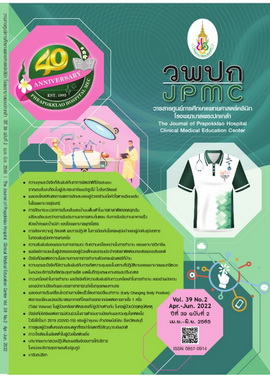Job Burnout and Related Factors among Disaster Prevention and Mitigation Officers in Bangkok
Main Article Content
Abstract
BACKGROUND: Job burnout is a result from chronic and unmanageable stress at work. Furthermore, burnout is a major problem in today's working-age people, especially in firefighters who must cope with physical and mental stressful situations that can finally lead to burnout.
OBJECTIVES: To examine the level of job burnout and the related factors among Disaster Prevention and Mitigation Officers in Bangkok, Thailand.
METHODS: This was a cross-sectional descriptive study. The subjects were 313 officers sampled by stratified and simple random sampling. The participants’ demographics, a work-related questionnaire, and the Maslach Burnout Inventory (MBI) were used to collect the data. The data were analyzed by using descriptive and inferential statistics with multiple logistic regression.
RESULTS: The results revealed that the officers experienced a low level of burnout in each dimension (84.0% in depersonalization, 75.4% in emotional exhaustion, and 48.2% in reduced personal accomplishment). Very few officers (8.31%) experienced a high level of burnout. Moreover, the results of the multiple logistic regression analysis showed the factors related to burnout were the economic status with insufficient income. Job dissatisfaction was associated with 9.9 times, the environmental dissatisfaction in the environment was 8.31 times, inadequate co-worker support was 3.38 times, and correlation was 2.56 times.
CONCLUSIONS: Many factors were related to the high level of burnout; such as, satisfaction in the workplace and receiving support from co-workers. Improvement of these factors may prevent officers from job burnout. In addition, these factors may be used as a policy for development; consequently, this would have a positive effect on the efficiency and safety of the work.
Article Details

This work is licensed under a Creative Commons Attribution-NonCommercial-NoDerivatives 4.0 International License.
References
World Health Organization. Burn-out an "occupational phenomenon: international classification of diseases[Internet]. 2019 [cited 2020 Nov 3]. Available from https://www.who.int/mental_health/evidence/burn-out/en/
Murphy SA, Beaton RD, Pike KC, Cain KC. Firefighters and paramedics: years of service, job aspirations, and burnout. AAOHN J 1994;42:534-40
Bangxang JN. Resident burnout: prevalence and associated factors in Rajavithi hospital. J Psychiatr Assoc Thailand 2019;64:61 76.
Katsavouni F, Bebetsos E, Malliou P, Beneka A. The relationship between burnout, PTSD symptoms and injuries in firefighters. Occup Med (Lond) 2016;66:32-7.
Smith TD, Hughes K, DeJoy DM, Dyal MA. Assessment of relationships between work stress, work-family conflict, burnout and firefighter safety behavior outcomes.Safety science 2018; 103:287-92.
Vinnikov D, Tulekov Z, Akylzhanov A, Romanova Z, Dushpanova A, Kalmatayeva Z. Age and work duration do not predict burnout in firefighters. BMC Public Health [Internet]. 2019[cited 2020 Dec 1];19(1):308. Available from: https://bmcpublichealth.biomedcentral.com/articles/10.1186/s12889-019-6643-2
Smith TD, DeJoy DM, Dyal MA, Huang G. Impact of work pressure, work stress and work-family conflict on firefighter burnout. Arch Environ Occup Health 2019;74:215-22.
Huynh JY, Xanthopoulou D, Winefield AH. Social support moderates the impact of demands on burnout and organizational connectedness: a two-wave study of volunteer firefighters. J Occup Health Psychol 2013;18:9-15.
Ogresta J, Rusac S, Zorec L. Relation between burnout syndrome and job satisfaction among mental health workers. Croat Med J 2008;49:364-74.
Rosca AC, Mateizer A, Dan CI, Demerouti E. Job demands and exhaustion in firefighters: the moderating role of work meaning. a cross-sectional study. Int J Environ Res Public Health [Internet]. 2021[cited 2021 Mar 14];18(18):9819. Available from: https://www.ncbi.nlm.nih.gov/pmc/articles/PMC8472436/
